
Welcome to The Regenerators.
Introduction
Symmetry is when one side of a shape is a mirror image of the other side.
Lots of buildings and everyday objects use symmetry because it looks appealing to the human eye.
But, if you step outside, into a garden, park or even the grounds at your school, you can also find symmetry in nature.
Finding symmetry in nature
Join Hannah and Maya as they meet up with Angela at Backwell Lake in North Somerset to look for symmetry around them.
(CHEERFUL MUSIC)
Hannah: I'm Hannah and this is Maya. And we have come to Backwell Lake in North Somerset. We are here to meet Angela, who is going to teach us all about symmetry.
Angela: Hi girls, great to meet you. It's brilliant to meet you outdoors, because we can learn absolutely anywhere. And it's so good to be in all this nature because it's so good for us.
Hannah: We want to find out more about what symmetrical means. So we are off to find somewhere comfortable to sit.
Angela: There are different types of symmetry, but we're going to talk about reflective symmetry. If you draw a line down something and the two sides are a reflection of each other, you have found the line of symmetry, or the mirror line.
Can you see the two sides of this shape? They're just flipped, or a mirror image. Can you find me something else on this board that's symmetrical? What do you think? You think that leaf might be symmetrical?
Hannah and Maya: Yeah.
Angela: Can we use the mirror to double check? So if we put it there and is it the same on both sides?
Hannah: Yeah
Angela: So you found the line of symmetry.
Maya: I think this leaf is also symmetrical. I think a line of symmetry would be there. I don't think this feather is, though.
Angela: Does it look as if it's the same on both sides?
Hannah and Maya: No.
Angela: Girls, I have a mission for you. Who wants to open it?
Hannah: I'll open it, and Maya, you can read it.
Maya: "Hannah and Maya, make some nature in a pattern using reflective symmetry." We could do a butterfly.
Hannah: Yeah, butterfly.
Angela: Brilliant idea. Let's make ourselves a line of symmetry. What should we start with?
Maya: Umm. Sticks?
Angela: Sticks. Let's get some sticks then.
Hannah: Is that gonna be the wing?
Maya: Now, we need one here.
Hannah: Shall we just use loads of these for them?
Maya: Maybe make it join up?
Hannah: Should I get some flowers to decorate?
Maya: Yeah, you grab the flowers.
Yeah, daisies are good. See? They're symmetrical.
(CHEERFUL MUSIC)
Hannah: Angela, we finished.
Angela: Wow, girls, this looks amazing! That's a perfect example of reflective symmetry. I'm going to take a photograph of it.
(CAMERA CLICKING)
(CHEERFUL MUSIC ENDS)
Reflective symmetry
A 2D shape is symmetrical if you can draw a line through the middle of it and either side is a reflection of the other.
There is a very famous example of symmetry in nature - the butterfly.
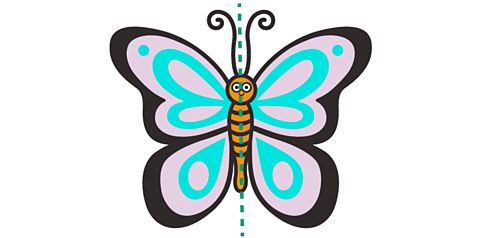
The dotted line down the middle is called a line of symmetry or mirror line, because if you place a mirror along it, the reflection looks exactly the same as the original.
This kind of symmetry is called reflective symmetry.
It's not just in butterfly wings that you can see reflective symmetry, have a look through the slideshow below to see some other examples.
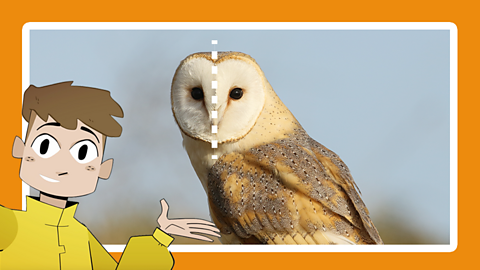
Image caption, Barn owl
You can see symmetry in the face of animals.
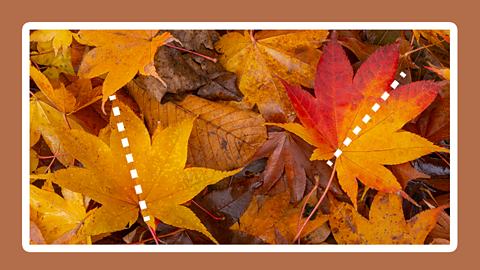
Image caption, Leaves
Or in the leaves on the ground or in the trees.
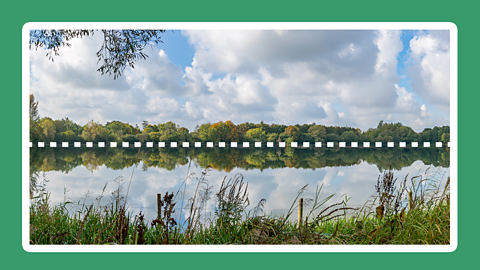
Image caption, Reflections
You can always find symmetry in the reflections in water.
1 of 3
Remember, a line of symmetry doesn’t always have to go from top to bottom and some shapes can have multiple lines of symmetry. Can you think of any examples?
Rotational symmetry
Symmetry isn’t always about mirrors and reflections.
Look at this spider’s web. It is the same whichever way round you look at it.
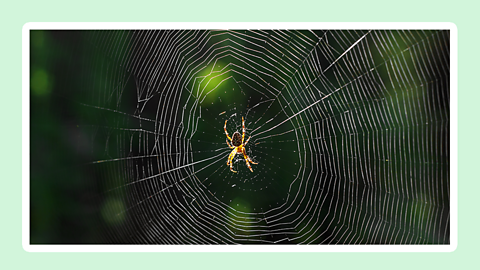
Image caption, Spider web
Often when you look at a spider's web, they are the same whichever way round you look at them.

Image caption, Snowflakes
The same goes for snowflakes up close in the winter. they show rotational symmetry.
1 of 2
This kind of symmetry is called rotational symmetry.
Rotational symmetry is where a shape or pattern can be rotated or turned around a point and it looks the same.
Lesson complete!
Well done Regenerator, you've completed this lesson. Now let's see what you can remember.
Leaf pressing symmetry
Have a go at this crafty activity to create your own symmetrical fabric art with this clip from the Springwatch Wild academy.
Equipment
- Leaves and flowers
- Fabric
- Hammer or heavy weight
- Hard surface
Expected durationApproximately 10 mins

Remember to get help from an adult when you're doing this activity.
Symmetry activities
Have a go at these symmetry activities below. Complete the missing side of these symmetrical images.
Symmetry sketches. documentSymmetry sketches
GREEN CLASSROOM

Create your own rotational symmetry flower. Cut out the petal template, place a dot in the centre of your page and rotate the template around this point, drawing around the petal to create a flower design.
Rotational symmetry. documentRotational symmetry
GREEN CLASSROOM

There's more to learn
Explore more lessons and content from around the BBC.
How can we look after our environment?
GREEN CLASSROOM

How to look for wildlife in your local space
GREEN CLASSROOM
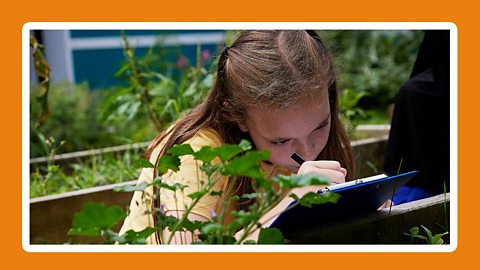
Year 3 - 6 and P4 - P7
GREEN CLASSROOM
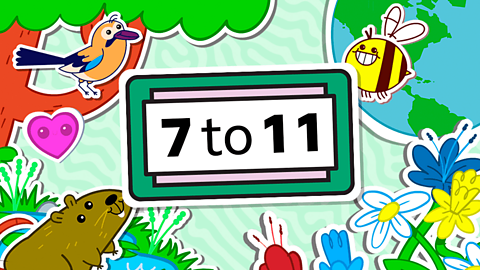
More from The Regenerators
BBC BITESIZE
